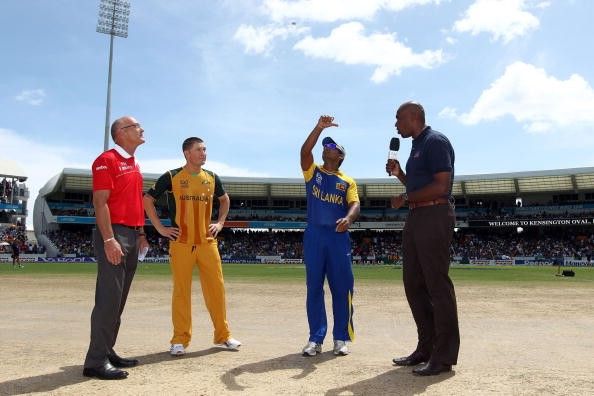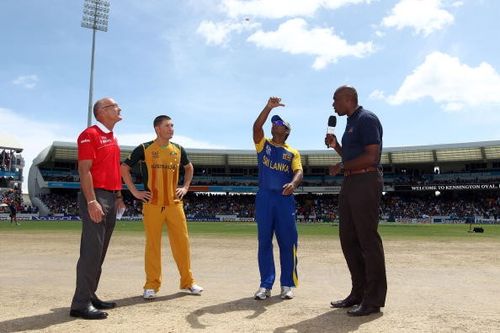
Kumar Sangakkara vs Michael Clarke: A statistical comparison

So cricket’s brain drain is almost complete with the retirement of Michael Clarke and Kumar Sangakkara. The last decade’s batch has almost graduated, leaving cricket in the hands of the budding and the burgeoning.
Both Clarke and Sangakkara have been pivotal for their teams. Sangakkara was Sri Lanka’s Atlas, often carrying his team’s batting solely on his shoulders. Clarke on the other hand, had to shoulder the burden of a team in transition that was forced to continue the good form of the once invincibles.
They were both similar in style. Aggressive but not arrogant. Attacking but not reckless. They could both bat with the silkiness associated with the batsmen belonging to the bygone era.
Numbers are what players play for, for it is numbers that separates a victor from the loser. But numbers are often hollow quantities that can provide mathematical solutions but can never differentiate one great from another. Hence, a statistical analysis is just a comparison of numbers and not an assessment of greatness or batsmanship.
Sangakkara has the better average of the two batsmen. He averages 57.41 in 134 Test matches, whereas Clarke boasts of an average 49.10 in 115 games. But both have had their difficulties.
Most part of Sanga’s initial days in cricket was spent behind stumps. Sitting, crouching, concentrating all day and then padding up to bat at number three is definitely an onerous task. AB de Villiers was forced to give up keeping so as to prolong his career and Brendon McCullum’s ailing back made him shed his gloves. All these suggest that wicket keeping is an arduous art and the physical demands of it can shunt batting.
Michael Clarke, however, had an infirm back to grapple with, which caused a great batting slump. Sangakkara averages 66.78 with the bat as a specialist batsman and Clarke’s average could have been in excess of 50 had his back been cooperative.
Kumar Sangakkara batted at number three for the most part of his career and has scored more runs than anyone else in that position. On numerous occasions he has been the virtual opener for his team, as the openers of Sri Lanka often got out in the first few overs of an innings.
He has also been the lynchpin of his team often facing tougher bowlers to make life easy for batsmen at the other end. The Australian right hander, meanwhile, often copped the blame for hiding behind the top order as he obdurately batted at number 5.
|
Name |
Matches |
Innings |
Runs |
Average |
Centuries |
Half centuries |
|---|---|---|---|---|---|---|
|
Kumar Sangakkara |
134 |
233 |
12400 |
57.41 |
38 |
52 |
|
Michael Clarke |
115 |
198 |
8643 |
49.10 |
28 |
27 |
The Sri Lankan southpaw has a far better average than Michael Clarke and has scored almost five thousand runs more than the Australian. He has also scored 10 centuries in excess and leads the Australian captain by 25 half centuries.
But often, Sanga finds himself at the receiving end of the argument that his stats are bloated by his exploits against both Zimbabwe and Bangladesh. Hence, it is important to evaluate their numbers leaving the games against Bangladesh and Zimbabwe.
The Sri Lankan master averages 52.60 in all Tests that were not played against Bangladesh and Zimbabwe while Clarke averages 49.37, which is better than his career average. The hike in the average is due to his lackadaisical performance against Bangladesh.
Performance at home
Michael Clarke averages 62.05 at home having scored 4654 runs in 53 Test matches. Sangakkara averages 60.44 in Sri Lanka in 75 games. Even though Clarke averages more than Sangakkara at home, the discrepancy is too small to give Clarke any significant advantage.
Sri Lankan pitches are generally spin friendly and Sanga’s numbers suggests his mastery over spin bowling. The Australian’s average suggests his aptitude against pace and bounce.
|
Name |
Matches |
Innings |
Runs |
Average |
Centuries |
Half centuries |
|---|---|---|---|---|---|---|
|
Kumar Sangakkara |
75 |
124 |
6830 |
60.44 |
22 |
25 |
|
Michael Clarke |
53 |
86 |
4654 |
62.05 |
17 |
13 |
|
Name |
Matches |
Innings |
Runs |
Average |
Centuries |
Half centuries |
|---|---|---|---|---|---|---|
|
Kumar Sangakkara |
11 |
22 |
862 |
41.04 |
2 |
5 |
|
Michael Clarke |
22 |
40 |
1435 |
39.86 |
3 |
6 |
As the above statistics suggest, Sangakkara has performed better than Michael Clarke in English conditions. But, it should also be mentioned that Sangakkara played all his Tests in England during the spring, during which the conditions are extremely seamer friendly.
Moreover, he hasn’t featured in a series that consisted of more than three Tests. Hence, he hardly had enough time to adapt to English conditions and was forced to score runs while he got acclimatized to the English conditions. Besides, Sangakkara often had the responsibility of seeing off the tougher bowlers for his team, while Clarke often fed off the performance of the top order.
With a good batting lineup to bat with, enough Test matches to get used to the English conditions and with the opportunity to bat during summer, Sangakkara could have had more in England. Nonetheless, his rendition in England is better than that of the Australian.
|
Name |
Matches |
Innings |
Runs |
Average |
Centuries |
Half centuries |
|---|---|---|---|---|---|---|
|
Kumar Sangakkara |
6 |
10 |
365 |
36.50 |
1 |
0 |
|
Michael Clarke |
13 |
25 |
972 |
40.5 |
3 |
4 |
Having made his debut In India, Michael Clarke averages 40.5 in India which is better than Kumar Sangakkara’s 36.5. But the startling fact is that despite being India’s neighbor, Sangakkara has played only 6 Tests in India in contrast to Michael Clarke’s 13 Tests.
Sangakkara played as a wicket-keeper in three of the Tests and in the remaining three Tests in which he played as a specialist batsman he has an average of 48.20.
|
Name |
Matches |
Innings |
Runs |
Average |
Centuries |
Half centuries |
|---|---|---|---|---|---|---|
|
Kumar Sangakkara |
6 |
11 |
549 |
61 |
3 |
0 |
|
Michael Clarke |
5 |
6 |
297 |
49.5 |
1 |
1 |
Much like Sangakkara in India, Clarke has surprisingly played only 5 matches in New Zealand. Sangakkara has played a Test match more in New Zealand but has had a far better average than that of Michael Clarke. Sangakkara averages 61 in New Zealand while the average of the Australian skipper is 49.5.
Sanga’s feats in New Zealand is phenomenal given the fact that he has scored profusely in swinging conditions at the difficult position of number three. He has three hundreds there, one of which was a double century. The southpaw also has a strike rate of 62.67 which is significantly higher than his career strike rate. This clearly elucidates his brilliance in pace friendly conditions, the perfect response to anyone who suspects his technique in testing conditions.
|
Name |
Matches |
Innings |
Runs |
Average |
Centuries |
Half centuries |
|---|---|---|---|---|---|---|
|
Kumar Sangakkara |
8 |
16 |
572 |
35.75 |
1 |
3 |
|
Michael Clarke |
8 |
16 |
528 |
40.61 |
2 |
1 |
The Australian has performed better than Kumar Sangakkara in South Africa, a country which has managed to trouble many of the world’s best batsmen.
Clarke’s highest score of 161 not out has ameliorated his average and that vouches for his innate ability to play colossal innings under testing conditions. Kumar on the other hand, has struggled in South Africa. One of the major reasons for his poor outcome there is that his team as a whole has struggled and Sangakkara was the only one who stood up as a lone warrior.
Moreover, the left hander has toured South Africa only thrice in his career, with the first of the three tours having transpired in his debut year. Nonetheless, Sangakkara’s 98 as an opener South African conditions and his century in Durban which became match-winning, vouches for his potential to play pace and bounce.
|
Name |
Matches |
Innings |
Runs |
Average |
Centuries |
Half centuries |
|---|---|---|---|---|---|---|
|
Kumar Sangakkara |
4 |
7 |
238 |
34 |
0 |
3 |
|
Michael Clarke |
7 |
13 |
435 |
39.54 |
1 |
1 |
Sangakkara has played only 4 matches in West Indies whereas Clarke has played 7 games in his 11-year career. Clarke averages better than Sangakkara with a century to his name, while West Indies is the only place where Sanga has not scored a century in.
But an argument that can be made in favor of Sanga is that he has played only one Test match in West Indies after 2006, a year after which Sangakkara started playing as a specialist batsman. However, the fact that Clarke was a better batsman than Sanga in West Indies cannot be allayed.
In Australia, Sangakkara averages 60.33 in five matches with one century. Clarke’s performance in Sri Lanka has been underwhelming with the three matches yielding 214 runs at an average of 42.80.
Even though stats give Sangakkara a clear advantage over Clarke, his contribution to Australian cricket cannot be ignored. With an ailing back and the pressure to sustain the brilliance of the previous Australian team, one must admit Clarke has lived up to his potential to an extent. Both of these fine stroke makers have scored plenty of runs and have given us thousands of memories to cherish.